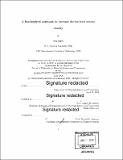| dc.contributor.advisor | Angela M. Belcher. | en_US |
| dc.contributor.author | Ransil, Alan Patrick Adams | en_US |
| dc.contributor.other | Massachusetts Institute of Technology. Department of Materials Science and Engineering. | en_US |
| dc.date.accessioned | 2019-02-14T15:47:26Z | |
| dc.date.available | 2019-02-14T15:47:26Z | |
| dc.date.copyright | 2018 | en_US |
| dc.date.issued | 2018 | en_US |
| dc.identifier.uri | http://hdl.handle.net/1721.1/120391 | |
| dc.description | Thesis: Ph. D., Massachusetts Institute of Technology, Department of Materials Science and Engineering, 2018. | en_US |
| dc.description | Cataloged from PDF version of thesis. | en_US |
| dc.description | Includes bibliographical references (pages 120-153). | en_US |
| dc.description.abstract | Battery research has historically focused on improving the properties of the active materials that directly store energy. This research has resulted in active materials with higher specific capacity, increased the voltage of batteries in order to store more energy per electron, and lead to the development of electrolytes and binders compatible with high-performance active materials. However, Lithium-Ion Batteries (LIB) are nearing the limits of energy density achievable using a traditional battery design. Structural batteries are a fundamentally distinct route to optimize device performance, aiming to replace structural materials such as metals, plastics, and composites with multifunctional energy-storing materials. By increasing the device mass fraction that is devoted to energy storage, this strategy could more than double the battery life of electronic devices without requiring improved active materials. In this thesis, I show that rigid, load-bearing electrodes suitable for structural batteries can be fabricated using a novel silicate binder. This binder .can be used to distribute load both within layers and throughout the battery by adhering adjacent battery layers. This innovation turns the entire battery stack into a novel monolithic engineering ceramic referred to as a Structural Ceramic Battery (SCB). Unlike previously published binders, this material does not soften with the introduction of electrolyte, it promotes charge transport within the electrode, and it is compatible with a range of active materials employed in batteries today. This thesis furthermore outlines versatile manufacturing methods making it possible to produce SCBs with a wide variety of shapes and form factors amenable to large-scale production. It is envisioned that this SCB architecture will be used to improve the energy density of both ground-based and flying electric vehicles, and that as improved active material chemistries are discovered they will be dropped in to this architecture in order to promote future increases in vehicle-level energy density. | en_US |
| dc.description.statementofresponsibility | by Alan Ransil. | en_US |
| dc.format.extent | 153 pages | en_US |
| dc.language.iso | eng | en_US |
| dc.publisher | Massachusetts Institute of Technology | en_US |
| dc.rights | MIT theses are protected by copyright. They may be viewed, downloaded, or printed from this source but further reproduction or distribution in any format is prohibited without written permission. | en_US |
| dc.rights.uri | http://dspace.mit.edu/handle/1721.1/7582 | en_US |
| dc.subject | Materials Science and Engineering. | en_US |
| dc.title | A bio-inspired approach to increase device-level energy density | en_US |
| dc.type | Thesis | en_US |
| dc.description.degree | Ph. D. | en_US |
| dc.contributor.department | Massachusetts Institute of Technology. Department of Materials Science and Engineering | |
| dc.identifier.oclc | 1083671544 | en_US |
